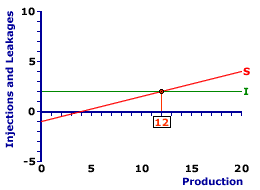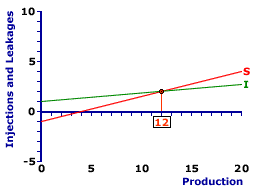
|
|
DISCRETIONARY: A specific choice, act, or decision, often designed to achieve a particular goal. The term is commonly used in economics in reference to government policies, such as discretionary fiscal policy or discretionary monetary policy. In both examples, government undertakes explicit actions through changes in government spending, taxes, the money supply, or interest rates to stabilize the business cycle. Discretionary is also frequently used to modify income, spending, expenditures, or comparable terms to capture choices made over the use of income. Discretionary income, for example, is the amount of after-tax household income that can be used for either consumption spending or saving.
Visit the GLOSS*arama
|
|


|

|
                           PARADOX OF THRIFT: The notion that an increase in saving, which is generally good advice for an individual during bad economic times, can actually worsen the macroeconomy causing a reduction in aggregate income, production, and paradoxically a decrease in saving. The paradox of thrift is an example of the fallacy of composition stating that what is true for the part is not necessarily true for the whole. The paradox of thrift is an analysis of Keynesian economics that illustrates fundamental differences between macroeconomics and microeconomics. The paradox is that an increase in saving, which is a recommended microeconomic strategy when individuals encounter problems, is not the best macroeconomic course of action for the aggregate economy.An increase in saving by the household sector necessarily goes hand-in-hand with a simultaneous decrease in consumption expenditures, and thus a decrease in aggregate expenditures. This decrease in aggregate expenditures then triggers the multiplier process and subsequently leads to a decrease in aggregate production. To the extent that saving and investment are both induce by changes in aggregate production and income, the saving is likely to paradoxically decrease below the level that existed before the initial change. The Fallacy of CompositionFirst consider the fallacy of composition. This is the logical fallacy of arguing that what is true for the parts is also true for the whole. In the study of economics, this takes the form of assuming that what works for parts of the economy, such as households or businesses, also works for the aggregate, or macroeconomy.This fallacy is most important for complex systems, such as the macroeconomy or the human body, that is composed of numerous different parts. The human body contains different organs, different types of cells, different components, all of which function separately and work together in the operation of the entire body. In a like fashion, the macroeconomy contains different markets, industries, buyers, sellers, consumers, and producers. These components are function separately but come together in the operation of the aggregate economy. The paradox of thrift is one of the better know examples of the fallacy of composition found in the study of macroeconomics. It demonstrates that what might be true for the part (more saving is better for an individual) is not necessarily true for the whole (more saving can be worse for the economy). The Injections-Leakages Model| The S-I Model | 
|
The paradox of thrift is best illustrated using the injections-leakages model. The exhibit to the right presents the simplest injections-leakages model that contains a single injection, investment, and a single leakage, saving. This simple saving-investment model, as such, contains a positively-sloped saving line, S, and a horizontal investment line, I. The intersection of these lines is the equilibrium, with aggregate production of $12 trillion. Saving MoreNow suppose that members of the household sector are concerned that a recession is forthcoming. Anticipating that their future incomes might decline, they are motivated to be a bit on the thrifty side. As such, they curtail current expenditure plans and devote more income to saving to protect against future problems. This is certainly sound advice for any individual. In total, the household sector increases saving by $1 trillion. Because this extra saving is NOT the result of a change in income it is an autonomous change. The increase in saving thus shifts the saving line upward. Click the [Increase Saving] button to illustrate. The result of this increase in saving is a new equilibrium. The new saving line intersects original investment line at $8 trillion of aggregate production. This new equilibrium is $4 trillion less than the original equilibrium. Concerns by the household sector of an upcoming recession, the act saving more to protect against an economic downturn, has in fact caused a downturn. What happened? The $1 trillion increase in saving necessitates a $1 trillion decrease in consumption. This is an autonomous decrease in consumption and like other autonomous expenditure changes, triggers the multiplier process that causes the $4 trillion decline in aggregate production. More saving means less production. Induced InvestmentWhile causing a recession by protecting against one is perplexing, the real paradox of thrift results from a slight modification of the saving-investment model. The change is to include induced investment expenditures.| The Paradox | 
|
The exhibit to the direct right illustrates an updated version of the saving-investment model that includes induced investment. The investment line, I, in this exhibit is positively-sloped. An increase in aggregate production induces an increase in investment expenditures. Or more to the point, a decrease in aggregate production induces a decrease in investment expenditures.To illustrate how this change creates a paradoxically result, click the [Increase Saving] in this exhibit. The $1 trillion vertical shift of this saving line is identical to the earlier exhibit. The result, however, is slightly different. The new equilibrium is achieved at the intersection of the new saving line and the original investment line. However, in this case equilibrium level of aggregate production is $6 trillion rather than $8 trillion. But that's not the paradox. The paradox arises because the equilibrium level of saving is LESS. Prior to the autonomous increase in saving, saving and investment were equal at $2 trillion. However, because investment is induced, the decrease in aggregate production causes a decrease in investment and thus the NEW equilibrium equality between investment and saving is $1.5 trillion, less than the original $2 trillion level. The paradox of thrift is that the act of increasing saving by individual members of the household sector ends up causing a decrease in saving for the entire household sector.

Recommended Citation:PARADOX OF THRIFT, AmosWEB Encyclonomic WEB*pedia, http://www.AmosWEB.com, AmosWEB LLC, 2000-2025. [Accessed: July 1, 2025].
Check Out These Related Terms... | | | | | | | | | | | |
Or For A Little Background... | | | | |
And For Further Study... | | | | |
Related Websites (Will Open in New Window)... | |
Search Again?
Back to the WEB*pedia
|



|

|
ORANGE REBELOON
[What's This?]
Today, you are likely to spend a great deal of time watching infomercials trying to buy either throw pillows for your bed or a package of blank rewritable CDs. Be on the lookout for mail order catalogs with hidden messages.
Your Complete Scope
This isn't me! What am I?
|

|
|
Only 1% of the U.S. population paid income taxes when the income tax was established in 1914.
|

|
|
"Experience keeps a dear school, but fools will learn in no other. " -- Benjamin Franklin
|

|
SPO
Strongly Pareto Optimal
|

|
|
Tell us what you think about AmosWEB. Like what you see? Have suggestions for improvements? Let us know. Click the User Feedback link.
User Feedback
|


|


